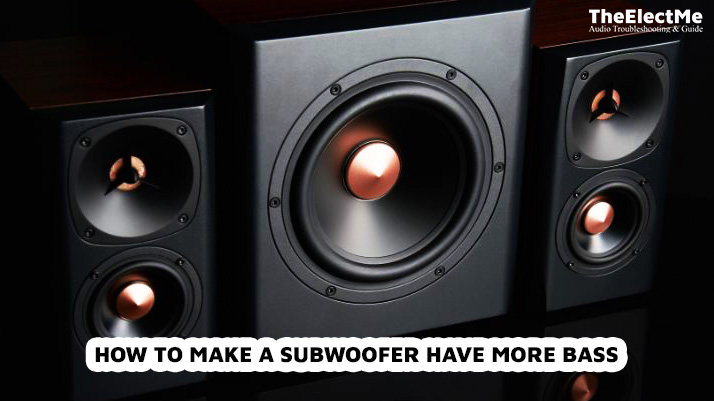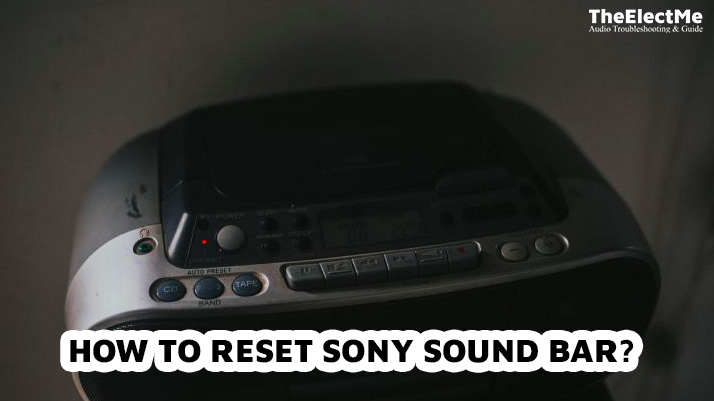A noisy and underwhelming subwoofer can be a frustrating experience for any music lover. To truly enjoy the deep and rich bass, it is essential to understand how to make a subwoofer have more bass. However, finding the right balance between overpowering bass and clear sound can take time and effort.

You may have tried adjusting the volume and bass levels but still not getting the desired results. Please don’t fret; we have gathered some expert tips and tricks to help you achieve that perfect bass boost for your music. So, let’s dive in!
Start with the factors that affect bass.
What Factors Affect The Bass Output Of A Subwoofer?
Before you start tweaking your subwoofer, it is essential to understand the factors that affect its bass output. This will help you make informed decisions while adjusting the settings.
1. Room Acoustics
Room acoustics greatly influence the quality of bass produced by a subwoofer. A room’s size, shape, and materials affect bass frequency interactions, leading to standing waves or uneven bass. Using acoustic treatments or strategically placing furniture can enhance bass clarity and impact significantly.
2. Subwoofer Placement
The placement of a subwoofer within a room is critical in maximizing bass quality. Placing the subwoofer near walls, corners, and listening areas minimizes acoustic cancellations and enhances bass frequencies. Experimenting with placement and using subwoofer calibration tools ensures deep, well-defined bass.
3. Speaker Settings
Adjusting speaker settings, such as crossover frequencies, phase alignment, and EQ, can significantly improve bass quality. Adjusting these settings lets users tailor the bass response to their tastes and room acoustics. People can enjoy balanced and immersive bass by tweaking speaker settings, acoustics, and subwoofer locations.
Let’s move to the expert tips on how to make a subwoofer have more bass!
How Do You Make A Subwoofer Have More Bass?
To increase the bass output of your subwoofer, consider these expert tips and tricks:
Adjusting EQ Settings
Adjusting the equalizer (EQ) settings can significantly impact the punch and clarity of the bass produced by a subwoofer. Here are some tips for fine-tuning EQ settings to achieve the desired bass levels:
- Increase the lower frequencies to enhance the deep rumble of the bass.
- Reduce frequencies that cause muddiness or distortion in the bass response.
- Experiment with different EQ presets or manual adjustments to find the optimal balance between punch and clarity.
- Use a spectrum analyzer to visualize the frequency response and make precise EQ adjustments.
Consider room acoustics when adjusting EQ settings to compensate for acoustic anomalies affecting bass perception.
Subwoofer Positioning
Proper subwoofer positioning is essential for maximizing bass response and overall sound quality. Here are some best practices for placing subwoofers to optimize bass performance:
- Experiment with subwoofer placement by moving it around the room to find the sweet spot with balanced bass distribution.
- Avoid placing the subwoofer in corners or against walls, as this can lead to boomy or uneven bass.
- Optimal positioning includes placing the subwoofer near the front of the room, away from walls, and at ear level for the best integration with other speakers.
- Consider using isolation pads or stands to decouple the subwoofer from the floor or walls, reducing unwanted vibrations and improving bass clarity.
- Utilize room correction software or manual tuning to fine-tune the subwoofer’s output based on its positioning within the room.
Sometimes short circuits damage the subwoofer wires. How to fix a short circuit in a subwoofer.
Follow these tips to find the perfect spot for your subwoofer and enjoy a well-balanced bass experience. Let’s explore the calibration and tuning options for a more precise bass boost.

Calibration and Tuning Techniques
You can use different calibration and tuning techniques to enhance the bass output of your subwoofer further. Some options include:
Subwoofer Calibration
Calibrating a subwoofer is crucial for achieving balanced bass distribution and optimal sound quality. Here’s a detailed process for calibrating a subwoofer effectively:
- Set the Subwoofer Level: Start by adjusting the subwoofer volume to a moderate level that complements the main speakers without overpowering them.
- Crossover Frequency Setting: Adjust the crossover frequency on the subwoofer to ensure it seamlessly integrates with the main speakers, typically around 80Hz for a smooth transition.
- Phase Alignment: Check the phase alignment of the subwoofer with the main speakers to avoid sound cancellation or reinforcement issues. Adjust the phase switch to achieve maximum bass impact.
- Room Correction: Use room correction software or an external calibration microphone to analyze the subwoofer’s frequency response in the room and make precise adjustments for optimal bass delivery.
- Fine-Tuning: Fine-tune the subwoofer settings by listening to test tones or music tracks with deep bass to ensure a well-balanced and immersive listening experience.
Room Acoustics Optimization
Room size, shape, and materials like subwoofer magnets significantly influence how bass resonates within a space. To optimize room acoustics for enhanced subwoofer performance, consider the following techniques:
- Bass Traps: Install bass traps in corners or along walls to absorb low-frequency energy and reduce bass buildup.
- Diffusers: Use acoustic diffusers to scatter sound waves and minimize bass reflections, creating a more even bass response throughout the room.
- Speaker Placement: Experiment with speaker placement to find the optimal position that minimizes bass nodes and enhances bass clarity.
- Room EQ: Utilize room EQ software to analyze and correct room acoustics issues that affect bass resonance, ensuring a more accurate and balanced sound reproduction.
Using these room acoustics techniques, users can improve their subwoofer’s potential and boost bass performance in their listening area. It also helps to improve the performance of distributed audio systems.
Consider upgrading your subwoofer’s hardware components when the above methods do not boost bass performance.
Advanced Tips and Tricks to Boost Bass Performance
For those looking to take their bass game to the next level, here are some advanced tips and tricks for boosting bass performance:
Bass Enhancement Strategies
Unlocking the full potential of subwoofer bass requires advanced techniques that enhance depth and punch without introducing distortion.
Here are expert recommendations for boosting subwoofer bass quality:
- Room Mode Correction: Use specialized room correction software to identify and compensate for room modes that may impact bass response.
- Dual Subwoofers: Consider adding a second subwoofer to your setup for more even bass distribution and increased bass impact.
- Bass Shakers: Experiment with bass shakers or tactile transducers to add a tactile dimension to low frequencies, enhancing the immersive quality of bass.
- Dynamic EQ: Utilize dynamic EQ processing to adjust bass levels in real time based on the content being played, ensuring consistent and impactful bass across various audio sources.
- EQ Presets: Explore custom EQ presets tailored for different music genres or movie genres to optimize bass response for specific content types.
Fine-Tuning Subwoofer Settings
Achieving optimal subwoofer performance involves fine adjustments to settings like gain control and crossover frequencies.
Here are insights into fine-tuning subwoofer settings for enhanced bass quality:
- Gain Control: Gradually adjust the subwoofer’s gain control to find the balance between bass impact and sound balance.
- Crossover Settings: Fine-tune the crossover frequency to seamlessly blend the subwoofer’s output with the main speakers, avoiding frequency overlap or gaps.
- Phase Correction: Check the phase alignment between the subwoofer and main speakers to ensure coherent bass reproduction without cancellation effects.
- Subwoofer Placement Optimization: If experiencing issues with bass response, experiment with different subwoofer placements to find the sweet spot that delivers the best bass performance in the room.
- Room Acoustics Analysis: Conduct a detailed analysis of room acoustics using measurement tools to identify acoustic anomalies impacting bass quality and take corrective measures.
With these tips, enthusiasts can boost their subwoofer performance for deeper, impactful bass that enhances their audio experience. How to blown out a speaker on TV?
Final Thoughts – How To Make A Subwoofer Have More Bass?
In conclusion, consider room acoustics, subwoofer placement, and speaker settings to improve bass quality. Calibration and tuning are essential for balanced bass and optimal sound quality.
Advanced tactics like room mode correction and using dual subwoofers can enhance bass depth and impact.
Adjusting subwoofer settings like gain and crossover frequencies is critical to improving bass quality. By using these strategies, enthusiasts can improve their audio systems for richer, dynamic bass, enhancing their listening experience.
So, don’t be afraid to experiment and fine-tune your subwoofer for the best bass performance possible.



